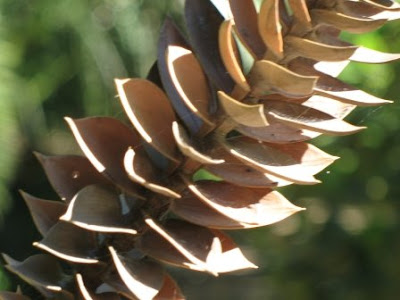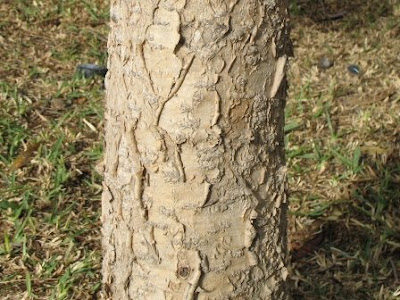 The Bunya Pine (Araucaria bidwillii) is a tree species native to Queensland, Australia and a member of the Araucaria genus. Some of its close relatives in this genus are the Monkey Puzzle tree, the Norfolk Island pine and the Cook pine. The Bunya pine is considered a "living fossil" as it is a tree species that is found in the fossil record in South America and Europe dating to the Jurassic period.
The Bunya Pine (Araucaria bidwillii) is a tree species native to Queensland, Australia and a member of the Araucaria genus. Some of its close relatives in this genus are the Monkey Puzzle tree, the Norfolk Island pine and the Cook pine. The Bunya pine is considered a "living fossil" as it is a tree species that is found in the fossil record in South America and Europe dating to the Jurassic period. The first picture of this post shows the light green juvenile leaves shortly after they have formed in the spring on a young tree. The image above is of the mature adult leaves that form on older trees. This one is from a whorled leaf stem that I found on the ground under a large tree. The leaflets on these mature trees are shorter, wider and stiffer than their juvenile counterparts.
The first picture of this post shows the light green juvenile leaves shortly after they have formed in the spring on a young tree. The image above is of the mature adult leaves that form on older trees. This one is from a whorled leaf stem that I found on the ground under a large tree. The leaflets on these mature trees are shorter, wider and stiffer than their juvenile counterparts. The seed cones of the Bunya pine closely resemble pineapples and in fact can grow to be larger than pineapples! The seeds that these cones produce are edible and have been used as a food source by aboriginal peoples. In the picture below you can see the pollen cones of the Bunya pine which are about 1.5 cm wide and 10-15 cm long. If you find one of these on the ground and shake it a large quantity of yellow pollen will fall out.
The seed cones of the Bunya pine closely resemble pineapples and in fact can grow to be larger than pineapples! The seeds that these cones produce are edible and have been used as a food source by aboriginal peoples. In the picture below you can see the pollen cones of the Bunya pine which are about 1.5 cm wide and 10-15 cm long. If you find one of these on the ground and shake it a large quantity of yellow pollen will fall out. The image below shows how the leaflets grow on the stem year around but vary in length depending on which season they grew in. Araucaria "pines" have a rather unique leaf system. The "branches" seen below are more like leaf stems than branches. The individual leaflets grow on the full length of the stem in a whorled pattern with approximately 150 leaflets on each. After about three years (my estimate) the stems turn brown and fall off the tree. They are about 3 feet (85cm) long at full length. For this reason the ground under these trees is usually covered with these dry leaf stems which are VERY sharp and prickly. Some of the stems don´t snap off but rather become to continuation of the main branch to which the rest of the stems are connected.
The image below shows how the leaflets grow on the stem year around but vary in length depending on which season they grew in. Araucaria "pines" have a rather unique leaf system. The "branches" seen below are more like leaf stems than branches. The individual leaflets grow on the full length of the stem in a whorled pattern with approximately 150 leaflets on each. After about three years (my estimate) the stems turn brown and fall off the tree. They are about 3 feet (85cm) long at full length. For this reason the ground under these trees is usually covered with these dry leaf stems which are VERY sharp and prickly. Some of the stems don´t snap off but rather become to continuation of the main branch to which the rest of the stems are connected. While this tree is native to Australia these pictures where taken in the South of Spain where they were planted in botanical gardens over a hundred years ago. The tall Bunya pine below is located in near the center of Malaga in what the locals call the "paseo del parque". I estimate the height of this tree to be about 40 meters (120-130 feet).
While this tree is native to Australia these pictures where taken in the South of Spain where they were planted in botanical gardens over a hundred years ago. The tall Bunya pine below is located in near the center of Malaga in what the locals call the "paseo del parque". I estimate the height of this tree to be about 40 meters (120-130 feet). The bark of the mature Bunya pines trees reminds me of chocolate with crunchy nuts. It is light brown, somewhat glossy and has a bumpy texture.
The bark of the mature Bunya pines trees reminds me of chocolate with crunchy nuts. It is light brown, somewhat glossy and has a bumpy texture. Below is an image of the juvenile bark on a young tree.
Below is an image of the juvenile bark on a young tree.
For more interesting Australian trees check out these...
Australian silver-oak
Bush Kurrajong
Coral Gum
Illawara Flame tree

Where I work there are two of these on the property. I just harvested two large cones full of seeds and would like to know the best way to plant them to grow new trees. Pease respond to radarnav12@hotmail.com
ReplyDeleteJim Elms
Merced, California
Jim, I live inS E Queensland, Australia where the trees are native,although the really large forests of them are about 150 kilometres north. I have grown them successfully on two occasions, the most successful being the last.
ReplyDeleteI filled a polystyrene vegetable box about 200 mm deep with washed river sand and place the nuts on their sides at about 70mm spacings. I then covered them with about 15 to 20 mm of sand and put them on the bottom shelf in my shade house and forgot them. They were kept moist from drips and spray from the watering system. 4 to 6 months later an exotic looking spike popped out of the sand, quickly followed by many more. Don't leave them too long to pot out or they will grow right through the bottom of the box. Put them into deep 150mm D pots in a soil rich in organic matter with a fertilizer with NO phosphorous.Phosphorous based fertilizers will kill almost every native Aus. plant
All they need is water,warmth and PATIENCE Good luck Peter Osborne
Bunya pines are a living dinosaur !! and have a perfect structure ! They once grew all over Queensland until climate change contained them to a small area ! A new species is now found in Papua New Guinea. I love this tree
ReplyDelete